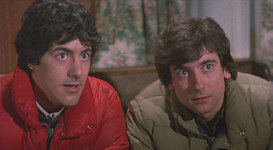 When it hit screens in 1981, An American Werewolf In London caused a sensation due to its groundbreaking visual effects. For the film’s key sequences in which a man turned into a werewolf, we actually got to see the transformation as it occurred. No more cut-aways or superimpositions; Werewolf pushed the envelope and created a shocking new way to depict these occurrences.
When it hit screens in 1981, An American Werewolf In London caused a sensation due to its groundbreaking visual effects. For the film’s key sequences in which a man turned into a werewolf, we actually got to see the transformation as it occurred. No more cut-aways or superimpositions; Werewolf pushed the envelope and created a shocking new way to depict these occurrences.
20 years later, those effects don’t hold up tremendously well, though they also don’t seem terrible. The movie itself remained notable mainly for its visual innovations. It did unspectacularly at the box office, but it maintained a decent cult following over the years. It also marked a trend toward a more comedic form of horror film, one that doled out irreverence and terror in nearly equal doses.
Personally, I never felt tremendously wild about Werewolf, but I think it offers a reasonably fun and compelling experience. The film follows the adventures of college friends David Kessler (David Naughton) and Jack Goodman (Griffin Dunne) as they backpack across England. While in a creepier part of the country, they happen upon a spooky pub called the Slaughtered Lamb. The inhabitants aren’t the friendliest folk, so our boys soon hit the road. Actually, they stray from the paved path despite multiple warnings not to do so, and they quickly discover the reasons for these admonitions when a beast kills Jack and wounds David.
The next thing we know, David’s hospitalized in London as he recovers from his wounds. There he meets - and falls for - sexy nurse Alex (Jenny Agutter) as well as Dr. Hirsch (John Woodvine). He also receives visits from the very-dead Jack who tells David he must die or he’ll become a werewolf. Slowly David starts to believe this, but he doesn’t get to the point where he can off himself. He tries to warn others of his impending transformation, but no one listens to him.
 Ultimately David’s discharged from the hospital, and he quickly shacks up with Jenny, who shows concern for his condition, especially since Hirsch has started to think there might be something to this werewolf business. Though they keep him home, David escapes when the big change occurs, and he hits the town for some nocturnal attacks. From there the movie deals with his status and works toward a conclusion, one that I won’t reveal here.
Ultimately David’s discharged from the hospital, and he quickly shacks up with Jenny, who shows concern for his condition, especially since Hirsch has started to think there might be something to this werewolf business. Though they keep him home, David escapes when the big change occurs, and he hits the town for some nocturnal attacks. From there the movie deals with his status and works toward a conclusion, one that I won’t reveal here.
On the surface, Werewolf offers nothing that one couldn’t find in any number of other films about the topic, but it differed in its execution. As I noted earlier, the movie walked the line between comedy and terror. In fact, so many people think of it more as the former that during an interview with director John Landis found on this DVD, he begins with a declaration that it’s not a full-out comedy.
Given Landis’ background with films like The Kentucky Fried Movie, Animal House and The Blues Brothers, I can understand why folks would feel predisposed to consider Werewolf as a comedy, and its tone makes it more sympathetic to that camp. The film presents normally horrific events in a humorous light, such as the gradual decomposition of Jack. He’s definitely not a spooky zombie; instead, Dunne plays him as his usual self, but with physical differences. The flick also takes a funny attitude with the aftermath of David’s first rampage.
However, when the movie needs to go for more intense terror, it doesn’t shy away from such areas. Landis proves to be surprisingly adept at the violent sequences, as some of the attacks work quite well. One that takes place in a tube station stands out particularly strongly, but all are fairly solid. I think the climax’s carnage goes on a bit too long and seems self-indulgent, but as a whole Landis stages these incidents in a concise and clear manner.
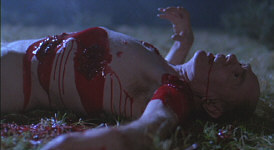 As for the actors, they seem competent but not exceptional. Dunne probably comes across as the most personable and effective, as he makes the most of his brief appearances. Naughton feels acceptably likable but he remains fairly drab. Agutter appears about the same, and the two show pretty light chemistry.
As for the actors, they seem competent but not exceptional. Dunne probably comes across as the most personable and effective, as he makes the most of his brief appearances. Naughton feels acceptably likable but he remains fairly drab. Agutter appears about the same, and the two show pretty light chemistry.
Nonetheless, the cast work reasonably well for the piece, and Landis paces it well for the most part. Actually, I must admit that I think he lets things sag a little too much at times. Between the attack on the boys and David’s first transformation, quite a lot of screentime passes without much other than exposition. Landis probably could have released the wolf a bit sooner, but I didn’t think this was a fatal flaw.
The first transformation itself is an interesting piece. Although I expected the usual bombastic horror score, Landis chose to accompany the change with a gentle version of “Blue Moon”. Though this could have appeared to undercut the drama, I felt it actually accentuated it, for the milquetoast tune highlighted the onscreen violence. It’s a neat way to make the experience stand out more starkly.
Ultimately, An American Werewolf In London offers a fairly solid experience. The film neatly straddles the realms of comedy and horror and becomes something new and fresh for the period. Even after 20 years, the movie holds up pretty well. Some of the effects show their age, but the story remains interesting, and the flick builds to a satisfying climax.
The DVD:
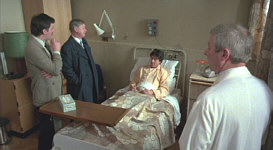 An American Werewolf In London appears in an aspect ratio of approximately 1.85:1 on this single-sided, dual-layered DVD; the image has been enhanced for 16X9 televisions. The picture started poorly but improved as it progressed, and it ultimately provided a flawed but watchable presentation.
An American Werewolf In London appears in an aspect ratio of approximately 1.85:1 on this single-sided, dual-layered DVD; the image has been enhanced for 16X9 televisions. The picture started poorly but improved as it progressed, and it ultimately provided a flawed but watchable presentation.
Sharpness consistently was a strong point. Throughout the film, I felt it always looked concise and crisp with virtually no signs of softness. The image stayed nicely detailed and accurate at all times. I saw no moiré effects or jagged edges, but some mild edge enhancement cropped up on a few occasions.
Colors appeared reasonably accurate, though they didn’t come across as anything special. The movie used a fairly subdued palette and never attempted anything bright or dazzling, so the acceptably precise and solid tones seemed sufficient. The hues appeared to adequately represent the objects.
Black levels were acceptably deep, though they could appear slightly drab. Shadow detail was usually decent, but it also showed some concerns. A fair number of low-light situations seemed to be somewhat thick and difficult to discern. They weren’t absurdly dark and impenetrable, but many of these shots looked too heavy. Interiors showed the most concerns, but some outdoors scenes also demonstrated them, especially due to the apparent use of day-for-night photography.
While some of the prior issues concerned me, the biggest problem found with Werewolf stemmed from print flaws. For the most part, the usual suspects remained minor nuisances. I saw occasional grit, speckles and other marks, but these were fairly infrequent. An odd jump occurred at the 13:11 point as well. On the other hand, grain showed up through quite a lot of the film. From the very start, it could be a heavy intrusion. As with the other defects, the grain cleaned up to a substantial degree as the movie progressed; it was much heavier during the film’s first half than through its second. Overall, An American Werewolf In London had some good moments, but the overall presentation couldn’t merit more than a “C+”.
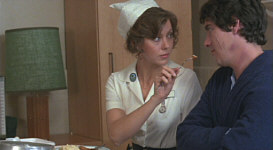 Somewhat better were the Dolby Digital 5.1 and DTS 5.1 soundtracks of An American Werewolf In London. Both tracks came from the movie’s original monaural audio, and if any differences existed between the two, I couldn’t discern them. The DTS and DD tracks sounded absolutely identical to my ears.
Somewhat better were the Dolby Digital 5.1 and DTS 5.1 soundtracks of An American Werewolf In London. Both tracks came from the movie’s original monaural audio, and if any differences existed between the two, I couldn’t discern them. The DTS and DD tracks sounded absolutely identical to my ears.
That was fine, since they both offered a dated but generally satisfying experience. The soundfield itself seemed to be surprisingly vivid and varied. Much of the track remained fairly heavily anchored to the center channel, but on many occasions, it spread nicely to the other speakers. Music showed good stereo separation, and the mix provided a very solid sense of atmosphere. Small sounded cropped up in the front side channels throughout the movie, and the rears added a nice feeling of environment.
During more lively scenes, however, the track became even more involving. Wolf howls would pop up in isolated rear channels, and the sound blended together fairly neatly for an active and useful mix. The ambience made the movie more effective and nicely complemented the action.
Audio quality showed its age but remained acceptable for its era. Dialogue demonstrated some of the most consistent concerns, mainly because speech seemed to be rather flat and mildly muffled throughout the movie. This was a vestige of its vintage, and although the lines didn’t sound very distinct or natural, they remained intelligible and free of edginess.
 Music and effects were less consistent. Elmer Bernstein’s score came across as somewhat muddy. It showed an emphasis on the midrange and lower realms and lacked bright, crisp highs. While overall fidelity seemed to be acceptable for its age, it still sounded a bit blah. Surprisingly, the pop/rock tunes heard throughout the movie appeared to be much more vivid. Tunes like Van Morrison’s “Moonglow” and CCR’s “Bad Moon Rising” sounded nicely rich and vibrant, which contrasted with the lackluster tones heard from the score.
Music and effects were less consistent. Elmer Bernstein’s score came across as somewhat muddy. It showed an emphasis on the midrange and lower realms and lacked bright, crisp highs. While overall fidelity seemed to be acceptable for its age, it still sounded a bit blah. Surprisingly, the pop/rock tunes heard throughout the movie appeared to be much more vivid. Tunes like Van Morrison’s “Moonglow” and CCR’s “Bad Moon Rising” sounded nicely rich and vibrant, which contrasted with the lackluster tones heard from the score.
Most of the effects presented fairly thin and flat tones, another artifact of their age. However, some of the sounds stood out as much clearer and more accurate. I believe that some of the stems were re-recorded for this DVD, which meant that elements like gunfire didn’t seem to mesh terribly well with older sounds. Oddly, this discrepancy favored the poorer audio quality; since so much of the track showed its 1981 roots, the newer, more accurate elements became a distraction. In any case, those were kept to a minimum. Although I had some qualms about the audio quality, I thought the mix sounded as good as most other 20-year-old films, and the strong soundfield boosted my rating to a “B”.
This new Universal release of An American Werewolf In London replaces an old version from Live Entertainment. I never saw the old disc, but I believe it included virtually no supplements. While the Universal Collector’s Edition doesn’t come totally packed, it nonetheless offers a nice selection of extras.
 First up is an audio commentary from actors David Naughton and Griffin Dunne. Both men were recorded together for this running, screen-specific track. On a few occasions they offered some good information, but as a whole this was a spotty and dull commentary. A great deal of the piece passed with no remarks from either, and a fait amount of the facts we did hear seemed a bit bland. They were most compelling when they discussed the makeup effects; one segment midway through the film included some nice details about their experiences. However, these moments were few and far between; this was a below-average commentary.
First up is an audio commentary from actors David Naughton and Griffin Dunne. Both men were recorded together for this running, screen-specific track. On a few occasions they offered some good information, but as a whole this was a spotty and dull commentary. A great deal of the piece passed with no remarks from either, and a fait amount of the facts we did hear seemed a bit bland. They were most compelling when they discussed the makeup effects; one segment midway through the film included some nice details about their experiences. However, these moments were few and far between; this was a below-average commentary.
Next we find Making An American Werewolf In London, a featurette that came out during the period of the film’s 1981 theatrical release. At five minutes and 15 seconds, this piece is too short to offer much depth, but it presents a reasonably interesting batch of notes. The shots from the set are especially useful, especially as they detail director John Landis’ cameo in the film.
Speaking of whom, he’s the subject of John Landis on An American Werewolf In London. Clocking in at 18 minutes and 15 seconds, this new interview with the director provides an entertaining look at the film. Landis covers quite a few topics, from the film’s origins and his intentions to a variety of aspects of the production. While I like his comments, I could have lived without the excessive number of movie clips. Landis is constantly interrupted with film snippets, and some go on for far too long. It’s fine to toss in a brief bit to illustrate a point, but I got the feeling the DVD’s producers forgot that we already own the movie.
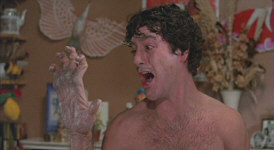 A companion piece appears as well. Rick Baker on An American Werewolf In London gives us 11 minutes and 10 seconds of the famous makeup artists thoughts about the flick. Baker neatly covers all of the relevant topics, from the transformation scenes to the mechanical wolf to the zombies; the brevity of the program means that we don’t get a wealth of information, but Baker makes the most with what he has. Happily, we don’t see the excess of film clips found during the Landis interview. Instead, we mainly find “unused footage” of the mechanical wolf and some other effects elements. These essentially give us a glimpse of the work behind the effects, and they’re a nice addition to the package.
A companion piece appears as well. Rick Baker on An American Werewolf In London gives us 11 minutes and 10 seconds of the famous makeup artists thoughts about the flick. Baker neatly covers all of the relevant topics, from the transformation scenes to the mechanical wolf to the zombies; the brevity of the program means that we don’t get a wealth of information, but Baker makes the most with what he has. Happily, we don’t see the excess of film clips found during the Landis interview. Instead, we mainly find “unused footage” of the mechanical wolf and some other effects elements. These essentially give us a glimpse of the work behind the effects, and they’re a nice addition to the package.
Another look at the creation of the effects pops up during Casting the Hand. This 11-minute piece shows exactly what the title states. We watch snippets of the process through which Naughton had to go to have his hand cast; it was then used to make a puppet for the transformation scene. Though the topic could have been dull, I thought it was an interesting look at this side of the business. The editing made sure that it didn’t literally de-evolve into watching cement harden. It’s not tremendously fascinating, but it was a reasonably fun look at the procedure.
More “behind the scenes” footage appears in the three minutes and five seconds of silent Outtakes. Unlike the usual batch of unused material, most of these don’t show mistakes made by the actors. Instead, they mainly offer shots just before or after takes. For example, we see the application of blood and goo onto Agutter prior to one shot. It’s a modest but interesting set of bits, especially with the inclusion of the nearly pornographic “Mysterious Footage” at the end.
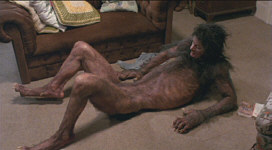 The Storyboards area provides a two-minute and 25-second look at the Piccadilly Circus climax. This running presentation shows the boards in the upper left corner of the screen with the movie itself in the lower right; the latter blows up to fullscreen when boards aren’t available for certain segments. I’m not a big fan of storyboards, but these appeared to be particularly well drawn, and the presentation seemed good.
The Storyboards area provides a two-minute and 25-second look at the Piccadilly Circus climax. This running presentation shows the boards in the upper left corner of the screen with the movie itself in the lower right; the latter blows up to fullscreen when boards aren’t available for certain segments. I’m not a big fan of storyboards, but these appeared to be particularly well drawn, and the presentation seemed good.
The Photograph Montage provides the usual mix of images. We find shots from the set, publicity stills, and pictures from the movie. All are backed with the movie’s score in this three minute and 40 second piece.
A few other bits round out the DVD. “Cast and Filmmakers” includes brief but decent biographies for Landis plus actors Naughton, Agutter, Dunne and John Woodvine, while the “Production Notes” adds some surprisingly detailed and interesting comments about the film. The DVD’s booklet includes an alternate text that gives us some additional information about the production. In the “Recommendations” area, we find a trailer for the 1941 version of The Wolf Man. Oddly, no trailer for American Werewolf itself or other Landis flicks like Animal House or The Blues Brothers make the disc.
DVD-ROM users can check out the Script to Screen feature. This shows the film’s screenplay on the right side of the monitor with the film in a box on the left. Finally, the DVD-ROM area provides links to: Universal DVD Newsletter; Universal DVD; Universal Home Video; Universal Pictures; and Universal Studios.
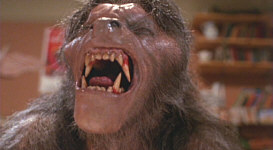 One nice touch: with the exception of the Wolf Man trailer, all of the above-listed video features provide subtitles. Not enough DVDs offer text with their supplements, which seems rather inconsiderate of the producers.
One nice touch: with the exception of the Wolf Man trailer, all of the above-listed video features provide subtitles. Not enough DVDs offer text with their supplements, which seems rather inconsiderate of the producers.
While it doesn’t match up with classic horror films, An American Werewolf In London still provides a nicely entertaining combination of scares and laughs. The movie combines two genres into a fairly effective package that still works well after two decades. The DVD offers erratic but watchable picture plus a good 5.1 soundtrack and some solid extras. The intense horror scenes make Werewolf less accessible for audiences who want a light laugh, but those who enjoy scary flicks and want a change of pace should get a kick out of it.